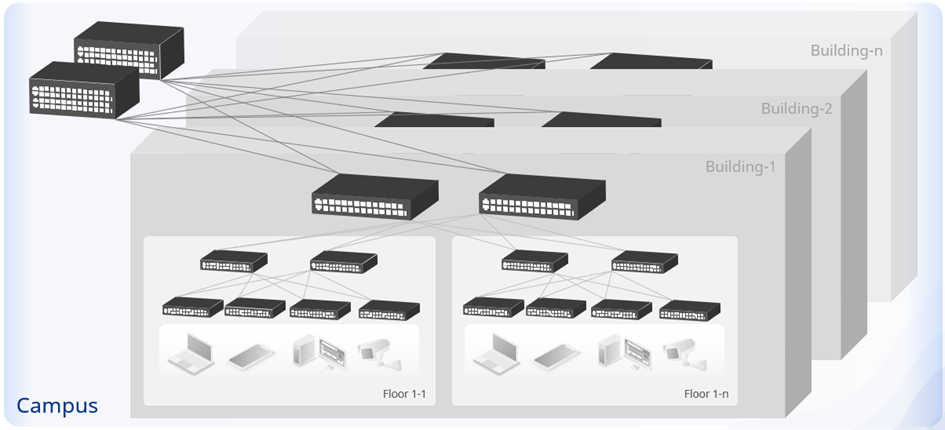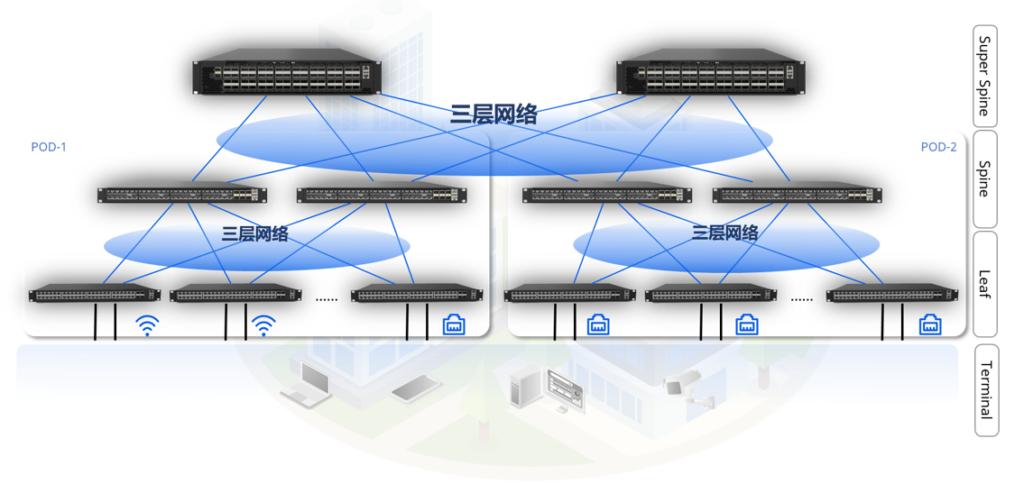Read more
Introducing Leaf/spine Network Architecture from DC to Enterprise Network
How to choose enterprise network architecture for your business?
The best option for a particular organization will depend on a number of factors, including the size and complexity of the organization, the types of applications and data that need to be supported, and the security requirements.
Here are some additional considerations that should be taken into account when choosing an enterprise network architecture:
- Scalability: The enterprise network should be able to grow with the organization as its needs change.
- Reliability: The enterprise network should be designed to minimize the risk of downtime.
- Security: The enterprise network should protect the organization’s data from unauthorized access, use, or disclosure.
- Cost: The cost should be justified by the benefits it provides.
Can the Leaf/Spine network architecture, which is maturely used in data centers, be used for enterprise office networks?
The answer is yes, the Leaf/Spine architecture, also known as a distributed core network, is derived from the Switch Fabric inside the switch, hence the name Fabric.
This advanced network architecture provides high-bandwidth, low-latency, non-blocking end-to-end connectivity, and is favored by large cloud data centers for its scalability, high reliability and high performance.
We have demonstrated the feasibility of applying technologies related to open networking in the cloud to the campus in eight dimensions.
Compared with the traditional “access-aggregation-core” network architecture, the Leaf/Spine architecture is flatter and easier to scale horizontally, while shortening the east-west communication path and reducing communication latency. With this architecture, we can use single-chip box switches to build a more efficient and streamlined next-generation enterprise network.
An example of a typical enterprise network configuration with Leaf/Spine architecture

Floor-wide, with access layer switches as Leaf and floor aggregation switches as Spine, constituting a first-tier network;
Building-wide, with floor aggregation switches as Leaf and building aggregation switches as Spine, constituting a second-level network;
Larger range, building aggregation switch as Leaf and higher level aggregation switch as Spine, forming the third level network;
Better scalability for enterprise network
As it scales, the network with the Leaf/Spine architecture is able to scale horizontally from one level to multiple levels, accommodating anywhere from tens to hundreds of thousands of campus access terminals, with the newly expanded modules (new access floors or buildings) all identical to the original.
Better bandwidth utilization for enterprise network
Under the Leaf/Spine network architecture, each node is a layer3-enabled switch, building up an IP-based layer3 network, which we call IP Fabric.
IP is a protocol that has been designed with loop avoidance, multi-path forwarding, high reliability and multi-path in mind, eliminating the need to introduce anti-loop mechanisms such as STP – combined with BGP routing and ECMP load balancing design, all physical lines in the campus network can theoretically be fully utilized, achieving 100% The network can achieve 100% bandwidth utilization and port utilization.
Simplifying Network Operations and Management
As mentioned earlier, the Layer 2 domain in the Leaf/Spine network architecture has been compressed below the access layer. During actual O&M management, administrators only need to set up different layer3 subnets to isolate different services, without the need to configure and maintain complicated layer2 functions such as various STPs, global VLANs, and broadcast suppression. At the same time, the full Layer 3 network environment also eliminates campus broadcast storms and various network viruses that rely on Layer 2 broadcast mechanisms.
About De-Stacking: Based on the natural high reliability and multi-path capability of the layer3 network, we can use a more reliable and easier to manage “cloud-based cluster” solution instead of a stacked group solution。
More adaptable to enterprise network trends
With the rise of the Internet of Things (IoT) and various mobile office services, the pressure on the access layer has increased dramatically. A large campus may have thousands of sensors, monitoring devices and smart terminals distributed to access the network, generating a large amount of east-west traffic.
The nodes in the Leaf and Spine layers are connected using Full-mesh, and communication between any two terminals is guaranteed to be completed within 3 hops. And because of the routing structure,all network communications make full use of all wires, the network communication quality is high performance, highly reliable and predictable.

In addition, it will be easy to continue adding either Spine or Leaf nodes in order to cope with the continued growth of network traffic in the future.
All of the above are offered by Asterfusion enterprise networking solution.


For more information, visit: https://asterfusion.com/enterprise_network/or send email to sales@asterfusion.com
© Asterfusion Data Technologies Co., Ltd. All rights reserved.